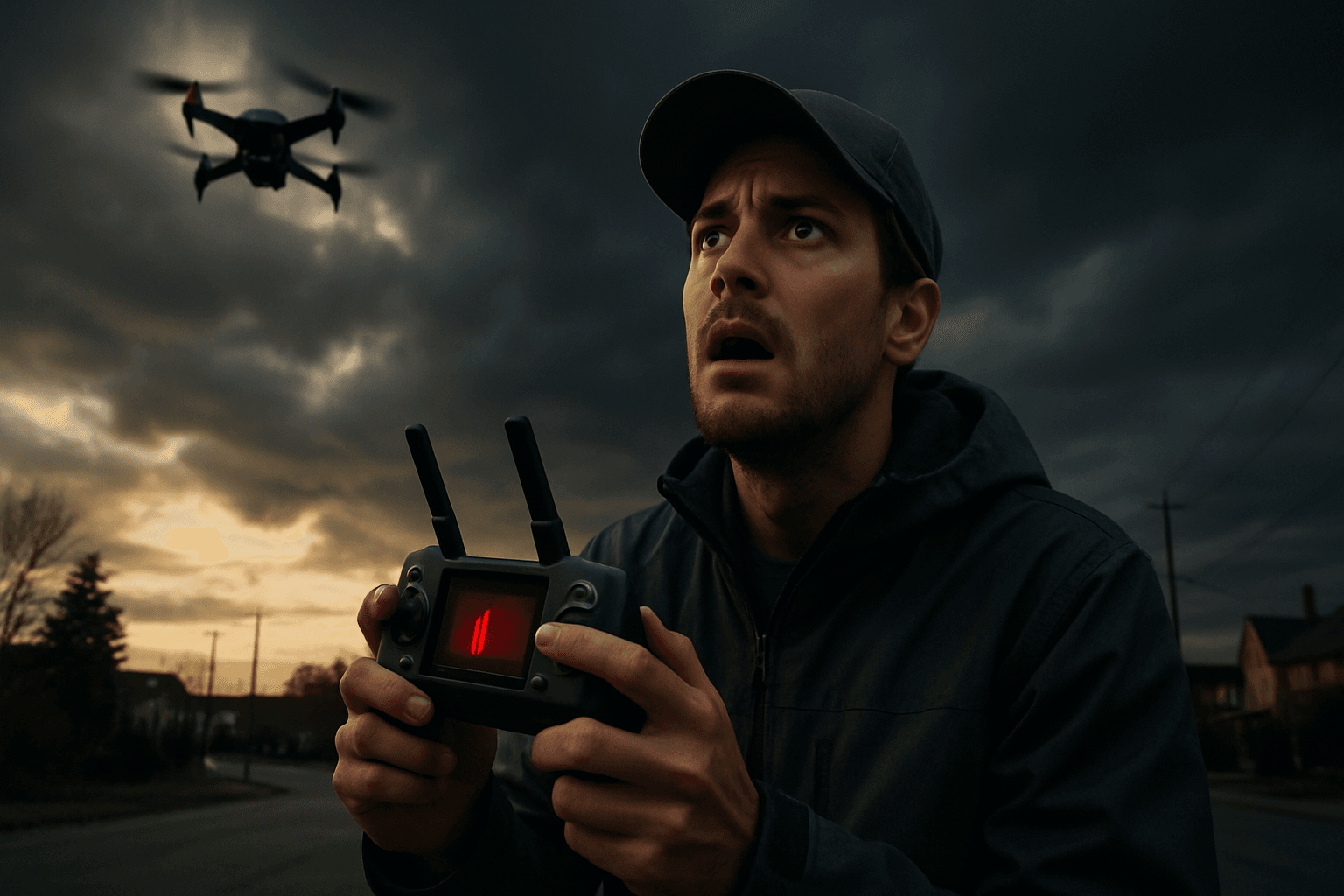Have you ever been flying your drone, capturing stunning aerial footage, when suddenly the signal drops out? It’s a heart-stopping moment for any drone pilot. Signal interference is a common issue, especially in urban areas, but understanding its causes and how to prevent it can save your drone and your peace of mind. This guide will explore the world of drone signal interference, from the common culprits to cutting-edge solutions, ensuring your flights are safe and successful.
What’s Bugging Your Drone? Common Causes of Signal Interference
Several factors can disrupt the communication between your drone and its controller. Understanding these causes is the first step in preventing signal loss:
Radio Frequency (RF) Congestion: Drones typically operate on the 2.4 GHz or 5.8 GHz frequency bands. These bands are also used by Wi-Fi networks, Bluetooth devices, cell towers, and other consumer electronics. In populated areas, these frequencies can become crowded, making it harder for a drone to maintain a stable connection. Airports, shopping malls, and high-density residential zones often have high RF activity.
Electromagnetic Interference (EMI): Electromagnetic fields from power lines, radio towers, industrial equipment, and high-voltage stations can create interference. Construction sites with heavy machinery and metal structures can amplify electromagnetic interference. Military and research facilities often emit high-frequency signals that can interfere with drones. EMI can disrupt a drone’s signal strength, affecting both remote control commands and GPS accuracy.
Physical Obstructions: Line-of-sight is crucial for maintaining a strong drone signal. Flying behind buildings, mountains, or dense tree canopies can reduce signal strength. Metal structures and reflective surfaces can cause signal multipath interference, where signals bounce unpredictably. Tunnels, bridges, and enclosed spaces often cause abrupt signal loss.
Weather Conditions and Atmospheric Interference: Environmental factors can impact signal strength and transmission reliability. Extreme temperatures, high humidity, and strong winds are particularly problematic for maintaining a reliable signal. High humidity is especially troublesome, as moisture in the air can disperse or weaken radio signals.
Distance: Radio signals weaken over distance. Exceeding the maximum transmission range of your drone can lead to signal loss.
Low Battery: A low battery in either the drone or the controller can weaken the signal.
Outdated Firmware: Outdated firmware in your drone or controller can cause signal problems.
GPS Jamming: GPS jamming blocks a drone’s ability to receive signals from satellites, which can severely impact its ability to navigate. Many drones rely on GPS for stabilization, waypoint flights, and return-to-home functions. Without GPS, a drone may drift uncontrollably or fail to execute automated flight patterns. GPS jammers flood the 1.5 GHz frequency bands used by satellite navigation systems, making it impossible for the drone to determine its position.
Remote Control Signal Jamming: Drone signal jamming occurs when an external device broadcasts powerful radio signals on the same frequency that a drone uses, effectively overwhelming or blocking its ability to receive commands, telemetry data, or GPS positioning.
The Ripple Effect: Consequences of Signal Interference
The consequences of signal interference vary depending on the severity and type of disruption:
Delayed or lost communication: Commands take longer to reach the drone, or the connection drops entirely.
Erratic flight behavior: The drone may not respond accurately to inputs, causing unpredictable movements.
Disrupted live video feed: Video transmission may experience lag, pixelation, or complete blackout.
Reduced flight range: The drone may lose connection at shorter distances than expected.
Increased crash or flyaway risk: If the drone loses connection entirely, it may fail to return home or enter an emergency landing state.
Shield Up! Strategies to Minimize Interference
Fortunately, there are many steps you can take to minimize signal interference and keep your drone connected:
- Fly in Low-Interference Environments: Avoid flying near power lines, cell towers, and industrial equipment that emit electromagnetic waves. Steer clear of metal structures and reflective surfaces, which can cause signal multipath interference. Choose open areas with a clear line of sight between the drone and the controller to maintain a strong connection. Be cautious in urban areas where overlapping Wi-Fi networks and Bluetooth signals can overwhelm drone communication systems.
- Maintain Line of Sight: Always keep your drone within visual line of sight.
- Choose the Right Frequency Bands: Drones primarily operate on two frequency bands: 2.4 GHz and 5.8 GHz. The 2.4 GHz band offers greater range but is more prone to congestion in populated areas. The 5.8 GHz band provides better resistance to interference but has a shorter range. If your drone supports it, switch to the 5 GHz channel, which is less crowded.
- Keep Your Equipment Up-to-Date: Always guarantee that your drone’s firmware is up to date, as manufacturers often release updates to improve signal performance and address known interference issues.
- Charge Up!: Always make sure both your drone and controller are fully charged before you start flying.
- Directional Antennas and Signal Boosters: Enhance a drone’s signal reception to help maintain a strong connection even in challenging environments. Directional antennas focus signal transmission in a specific direction, increasing range and reducing interference. High-gain antennas provide a stronger signal than standard antennas, improving stability over longer distances. Signal boosters amplify signals between the controller and drone, helping maintain communication even in high-interference zones.
- Adaptive Frequency Switching and Dynamic Spectrum Management: One of the most promising developments in drone communication security is dynamic spectrum management, which allows drones to actively switch between different frequency bands to avoid interference. Future drones will leverage cognitive radio technology, which enables real-time frequency scanning and automatic selection of the most stable channels. Multi-band communication systems will allow drones to operate across multiple frequencies simultaneously, reducing the likelihood of total signal loss. Some drones automatically switch between channels to avoid crowded frequencies, reducing interference risks.
- Set Return-to-Home (RTH) Parameters: In case of signal loss, ensure your drone is programmed to automatically return to its home point.
- Fly Higher: Jammers are often ground-based. Flying higher may move the drone out of range of interference.
Advanced Tech to the Rescue: Anti-Jamming Solutions
For more serious interference threats, advanced anti-jamming technologies are available:
- Multi-Constellation GNSS Receivers: Instead of relying solely on GPS, these systems use multiple satellite networks, such as GLONASS, BeiDou, and Galileo, for better resilience against jamming.
- Anti-Jamming GPS Modules: Specialized GPS receivers that filter out interference and maintain stable satellite connections.
- Jamming Detection Features: Some high-end drones include built-in jamming detection features that alert pilots when interference is detected. If jamming is suspected, switch to manual flight mode to prevent disorientation.
UK Drone Laws and Signal Jammers: A Word of Caution
In the UK, it’s crucial to understand the legal implications of using signal jammers. The Wireless Telegraphy Act 2006 regulates the use of wireless equipment, including jamming devices.
- Legality: It is illegal for civilians to use drone jammers in the UK. Only authorized entities, such as the military, law enforcement agencies, and government bodies, are permitted to use anti-drone guns or similar technologies.
- Consequences: Unauthorized possession or use of RF jamming equipment can result in significant legal penalties, including fines and imprisonment.
- Alternatives: If a drone is invading your privacy or trespassing on your property, do not deploy a jammer. Instead, report the incident to the police or the Civil Aviation Authority (CAA).
Drone Frequency Bands: What You Need to Know
Drones communicate using radio frequencies, and understanding these frequencies is key to avoiding interference:
- Common Bands: The most common bands for drone communication are 2.4 GHz and 5.8 GHz. Some drones also use 1.2 GHz and 1.3 GHz bands.
- Frequency Hopping: Some drones automatically switch between channels to avoid crowded frequencies, reducing interference risks.
- Other Bands: Amateur-built drones sometimes use 433MHz or 915MHz.
Here’s a list of common UAV frequency bands:
- 900 MHz band: 902 MHz – 928 MHz
- 2.4 GHz band: 2400 MHz – 2500 MHz
- 5 GHz band: 5000 MHz – 5725 MHz
- 5.8 GHz band: 5725 MHz – 5875 MHz
- SRD860 band: 865 MHz – 870 MHz
- LPD433 band: 433.050 MHz – 434.775 MHz
Jamming Techniques: A Look Under the Hood
While using jammers is illegal for most individuals in the UK, understanding how they work can help you recognize and avoid potential jamming situations:
- Broadband Jamming: Transmitting high power noise across a broad range of frequencies, covering the drone’s communication channels.
- Spot Jamming: Focusing on a specific frequency band used by the drone, providing a more targeted and efficient disruption.
- Barrage Jamming: A combination of broadband and spot jamming, targeting multiple frequencies simultaneously to ensure disruption.
- GPS Jamming: Blocking GPS signals, causing drones to lose their position data.
Staying Safe and Legal: UK Drone Regulations
To fly your drone safely and legally in the UK, it’s essential to follow the regulations set by the Civil Aviation Authority (CAA):
- Registration: If you own or are responsible for a drone or model aircraft weighing 250g or more, or any drone with a camera (unless it’s a toy), you must register with the CAA.
- Flyer ID: Anyone flying a drone weighing 250g or more must have a Flyer ID, obtained by passing an online test on drone rules and regulations.
- Height Limit: Drones must not be flown higher than 120 meters (400 feet) above ground level.
- Line of Sight: Operators must maintain a visual line of sight with their drone at all times.
- Restricted Airspace: Permission is required before flying in restricted airspace, such as Flight Restriction Zones (FRZs) around airports.
- No-Fly Zones: Drones should not be flown over large gatherings of people or in prohibited areas.
- Labelling: Label your drones with your operator ID.
By understanding and adhering to these regulations, you can ensure that you’re flying your drone safely, legally, and responsibly.
Final Thoughts: Fly High, Stay Connected
Drone signal interference can be a frustrating and potentially dangerous issue, but with the right knowledge and precautions, you can minimize the risks and enjoy safe, successful flights. By understanding the causes of interference, implementing preventative measures, and staying informed about the latest technologies and regulations, you can keep your drone connected and your aerial adventures soaring.





